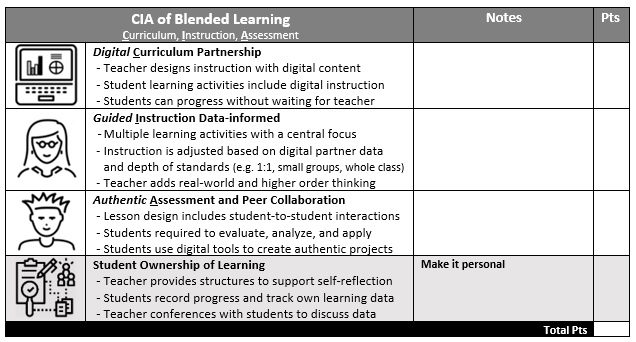Blended learning, when teachers partner with digital content to create a personalized learning environment, may be difficult to measure – but not impossible. Measuring a pedagogical shift requires data collection from classroom observations using a walkthrough tool. Establishing a blended classroom walkthrough tool begins with identifying observable actions such as the implementation of the CIA of Blended Learning. This includes the one-third, one-third, one-third balance:
- utilizing digital Curriculum to deliver low level basic understanding, skills, and practice,
- partnered with extension into higher order thinking via teacher guided Instruction,
- plus student engagement, project learning, and peer collaboration via the 4Cs – communication, collaboration, creativity, critical thinking through authentic Assessment.
Measuring a pedagogical shift, is focused on only one of the four P’s of evaluating the effectiveness of a blended program: Performance, Pedagogy, Perception, and Partnership. When measuring a pedagogical shift (a process measure) we are seeking an answer to: Is classroom instruction changing (and how)? To answer this question, we use a classroom walkthrough tool to collect data. The walkthrough tool should be developed in-house and focused on self-selected priority practices and instructional strategies.
The CIA of Blended Learning balance of one-thirds: digital, teacher, and student is a great place to begin when developing a classroom walkthrough tool. Typically, classroom walkthroughs are just a snapshot of the learning. Observer(s) may only be in the room ten minutes, looking for a handful of items. When working with schools and districts in the implementation of the CIA of Blended Learning we help them identify a handful of goals and priority practices that are expected when transitioning to a blended personalized learning environment. Through this conversation schools/district add specific items or expectation to the walkthrough tool (e.g. classroom culture, station rotation). We also include the CIA of Blended Learning categories, plus a ‘student ownership’ personalization item, as seen below (Google version here).
A site-specific walkthrough tool can be developed using the CIA Blended Classroom Walkthrough Tool as the foundation. Point values are assigned by observers noting if specific criteria was observed: 0 pts=Not observed, 1 pts=Somewhat observed, 2 pts=Mostly observed, 3 pts=Fully observed
By collecting data in the fall, or during the early stages of implementation, and again in the spring, or late in the implementation, we can track the changes in classroom pedagogy over time. This allows teachers time to fine-tune their practice and make the mind and pedagogical shifts needed when partnering with digital content in a blended personalized learning environment. No worries if the point values are low to start, that gives a base line and room for improvement over time. We are looking for growth, so low points to start is not bad – just a starting point to build upon.
Classroom walkthroughs should include talking to students. Student perception is one of the four P’s of evaluating the effectiveness of a blended program. Here’s a few questions to consider:
- What are you learning about today?
- What do you like about this classroom?
- What are your thoughts on digital learning?
- How do you keep track of what you do online?
- What is your favorite thing about blended learning?
Try the CIA Blended Classroom Walkthrough Tool below. Ask your students the questions above. Find your baseline data and start the growth process to a blended personalized learning classroom, school, or district.


